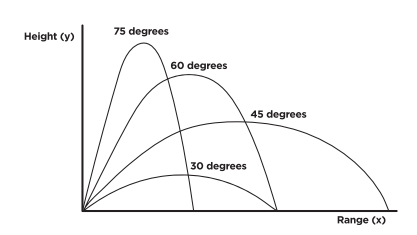In this activity, students use pop bottle rockets to learn about the path of projectiles by testing rocket launches at different angles.
2L pop bottle rockets are an excellent way to demonstrate the effects of forces on objects and provide many opportunities for observing, predicting, measuring and carrying out experiments while controlling for variables.
Part II of this series of activities demonstrates how different launch angles can affect the distance a rocket travels. A basic understanding of rocket trajectories will help you increase how far your rocket flies (its range).
You can do this activity on its own or in combination with Part I and/or Part III of this series for a deeper investigation into forces and rocket flight.

Projectile Motion
If you’ve thrown a ball, you’re familiar with the curved path (trajectory) followed by a moving projectile. The shape of the trajectory of a projectile is probably familiar to you–it is a parabola (an upside-down U-shape).
When you launch a pop bottle rocket, it is moving both upward and forward. All other things equal (the mass and design of the rocket, the pressure at which it is released, and the weather conditions), the angle at which you launch your rocket will determine its range (the horizontal distance it travels).
For example, here are four different launch angles:

If you launch a rocket straight up, it goes very high but comes back to earth quite near the launching pad. If you launch it almost horizontally, gravity brings it down to the ground before it can travel very far. In between is an angle (45 degrees, in the absence of significant air resistance) that will let the rocket travel horizontally as far as possible before gravity brings it back to Earth.
Safety Tips:
Flying bottle rockets is a lot of fun, but be sure to take safety precautions seriously:
- Rockets travel far; do not do this activity indoors.
- Every launcher should be supervised by an adult.
- Do not pressurize the rocket past 40 psi (pounds per square inch).
- When pressurizing and launching the rocket, everyone should stand well away from the launcher. Make sure that all observers know that a rocket is about to be launched–a countdown and safety zone combination work well for this.
- Watch the rocket’s entire flight to make sure it doesn’t hit anyone as it falls.
- Use only paper/cardboard fins, never metal.
- Wear eye protection.
